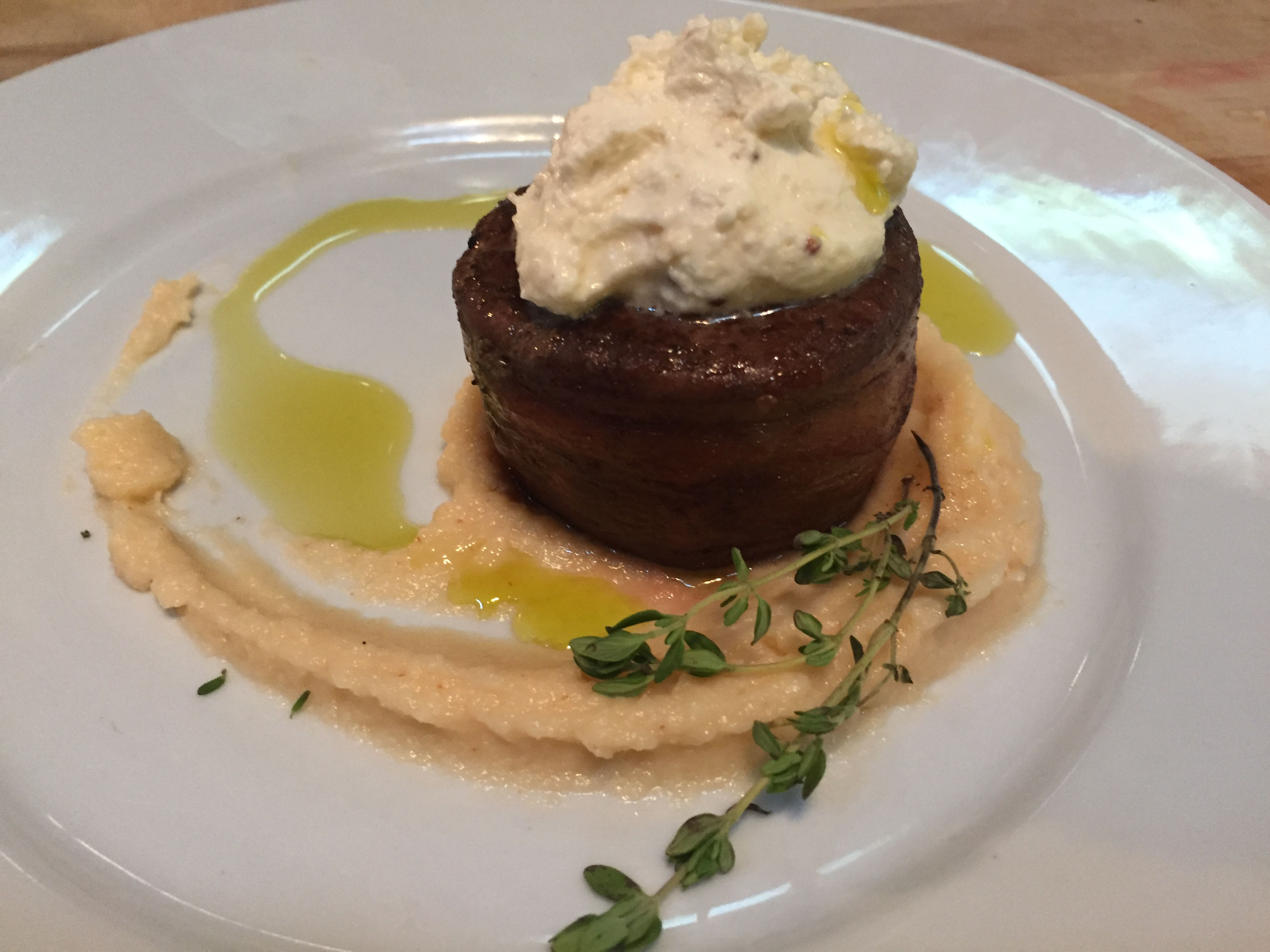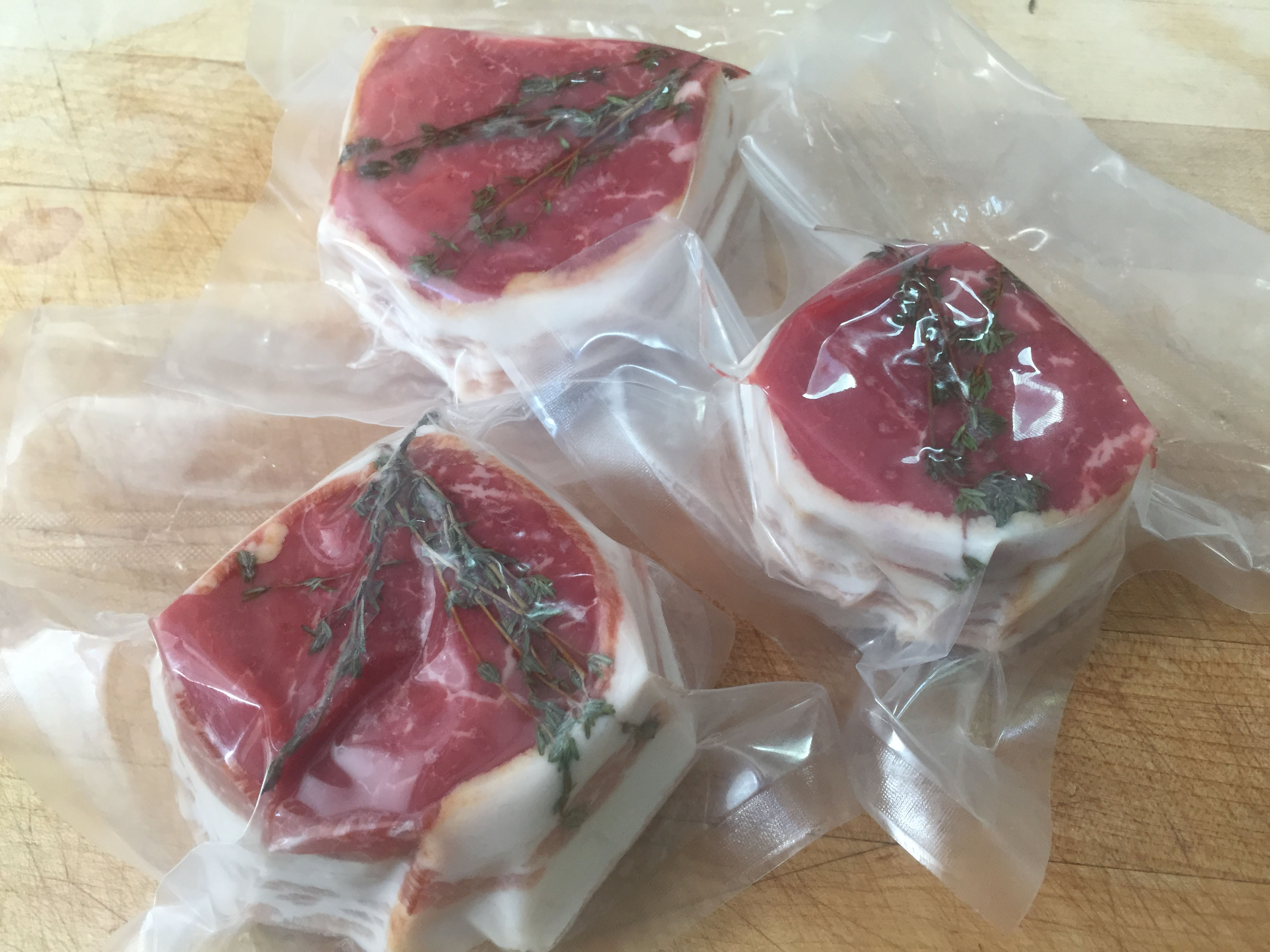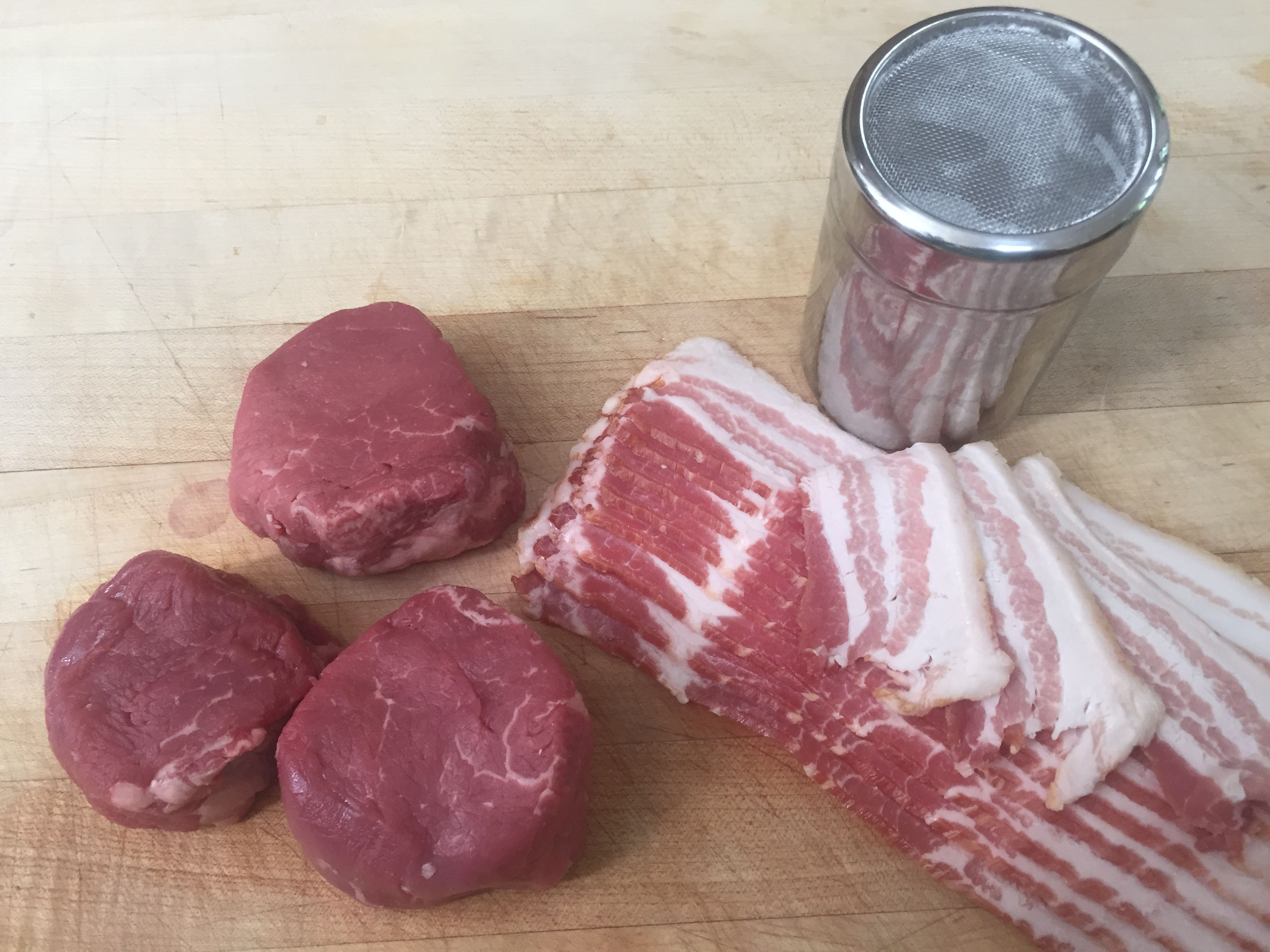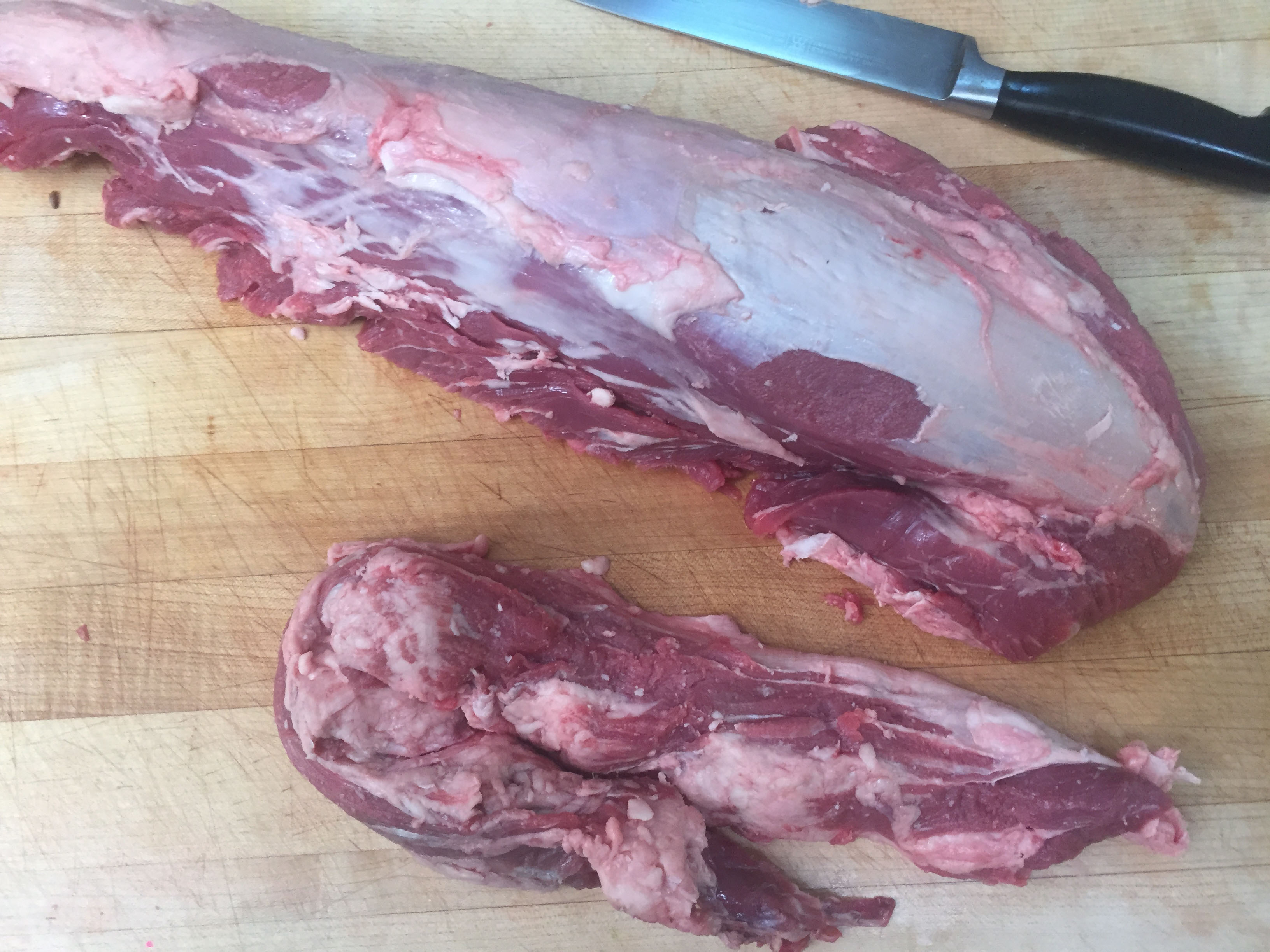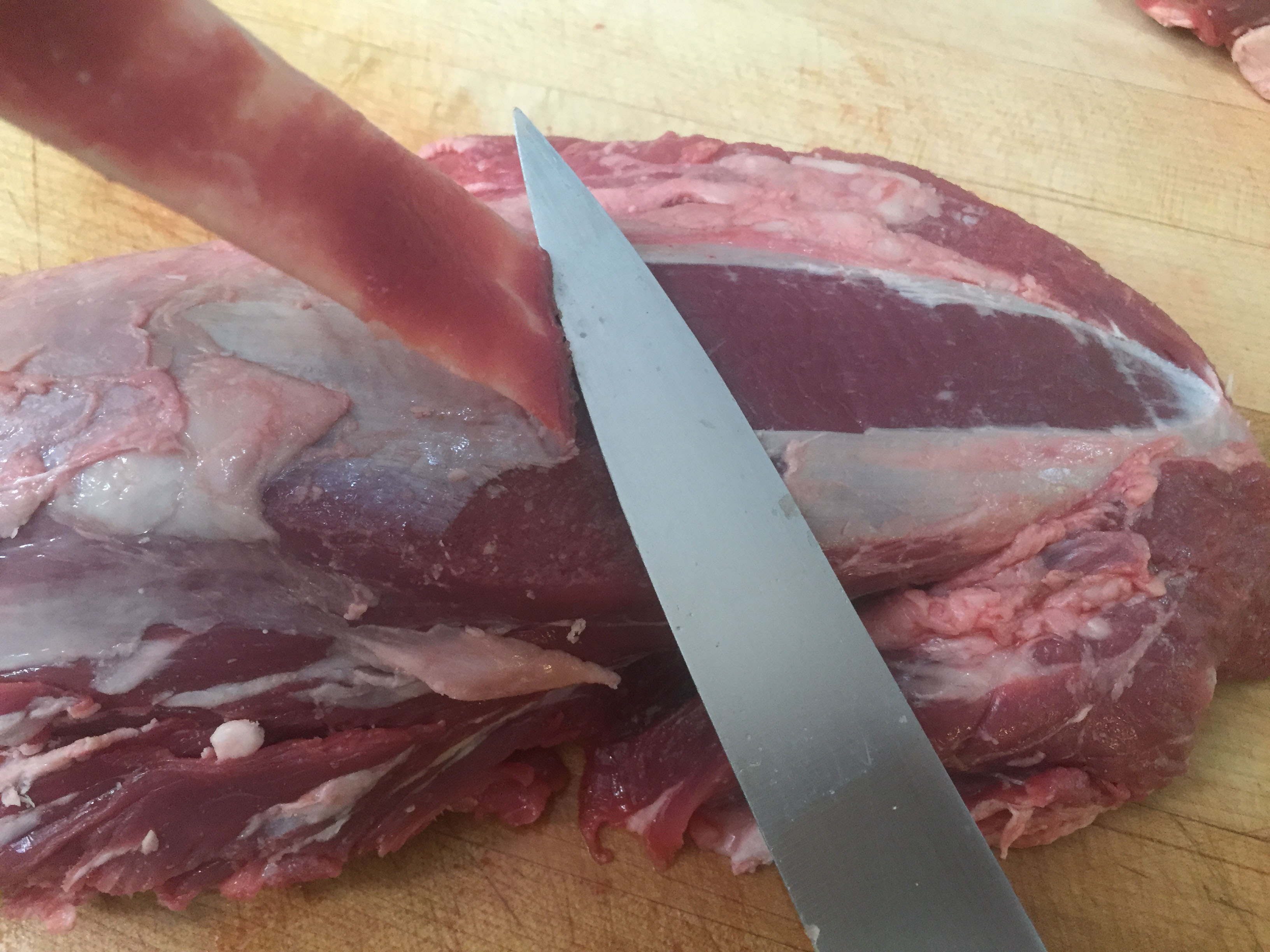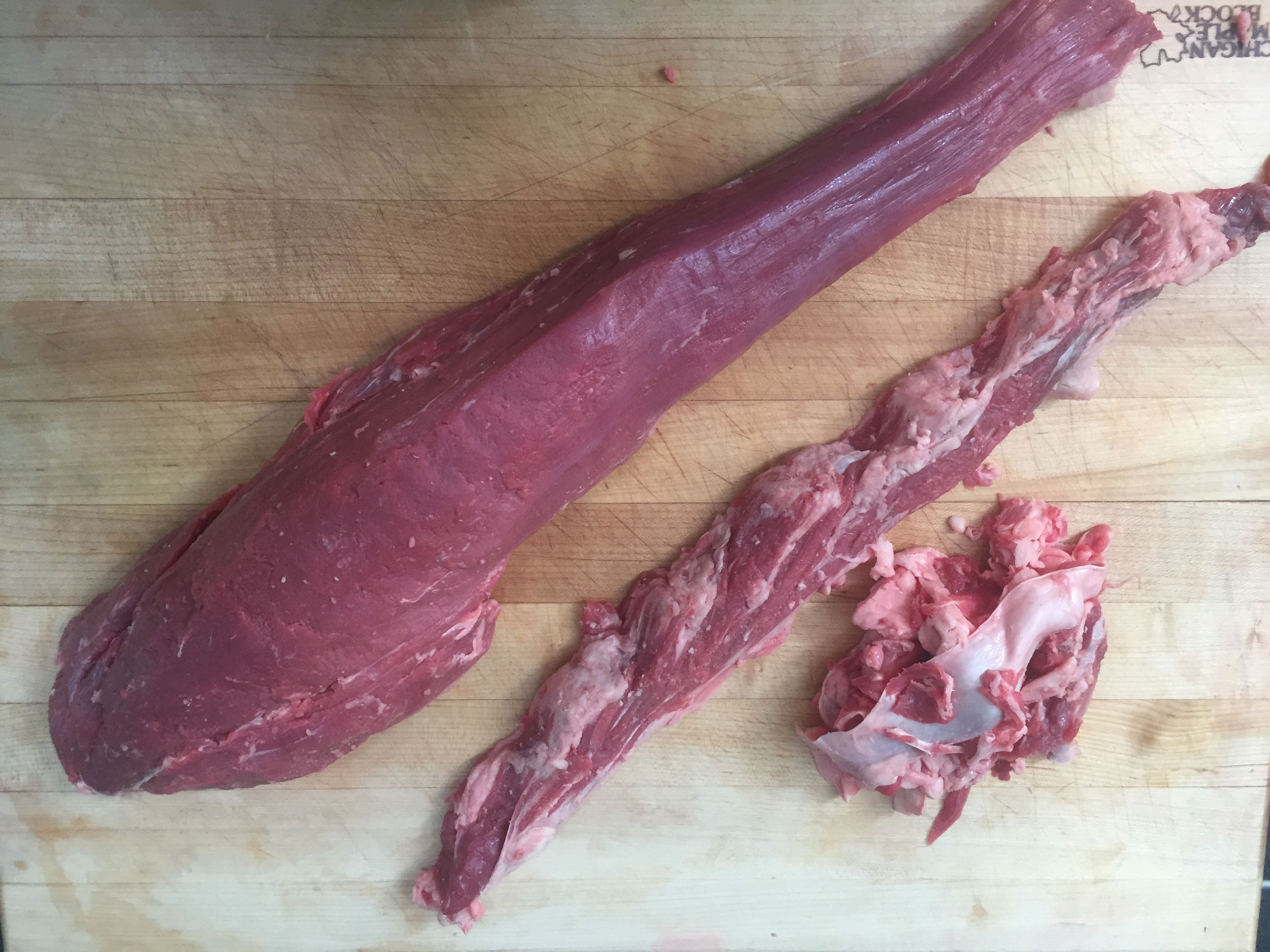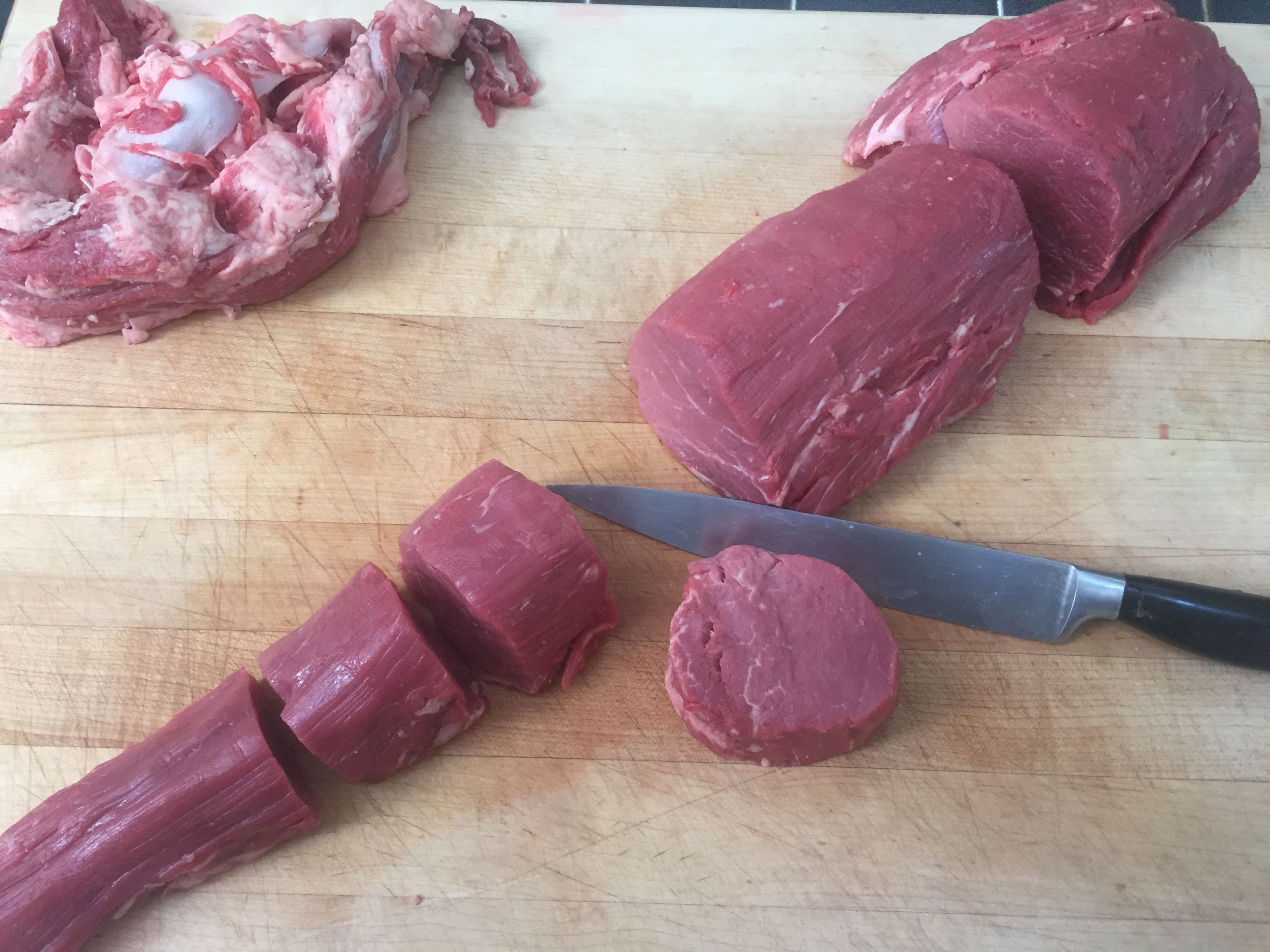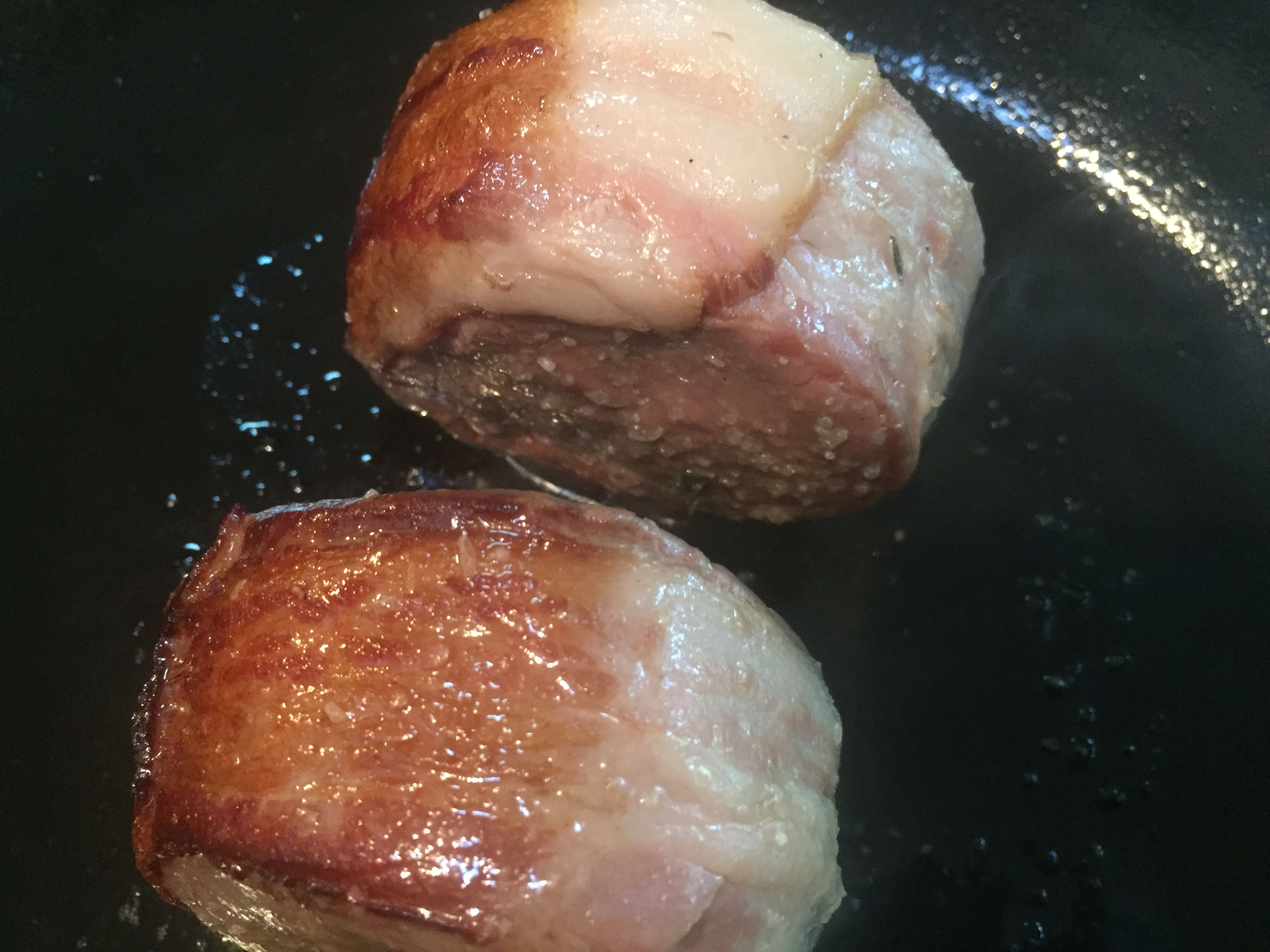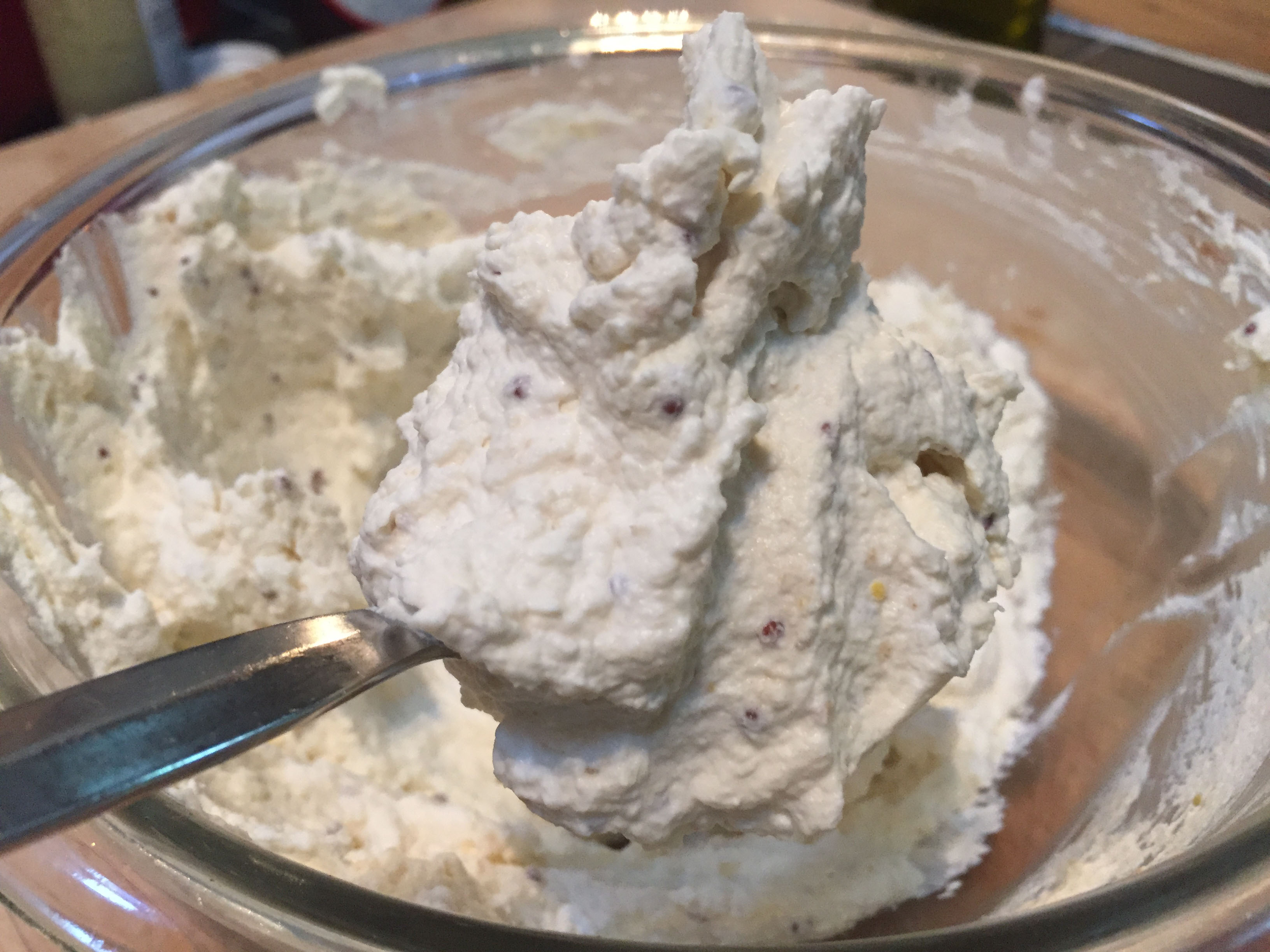Filet Mignon with Bacon Wrap and Whipped Horseradish Cream Sous Vide

| Filet
Mignon, the storied steak cut from the beef tenderloin is considered by many to
be the prized cut of cow. A whole beef tenderloin is an oblong shaped muscle,
which sits beneath the ribs and next to the backbone. As it’s isolated and does
very little, if any work, it’s the tenderest part of the beast. But it’s the
Filet Mignon that is the prize to countless carnivores. So where does one find
this stellar steak? Well, I can say with some certainty that all Filet Mignons
are tenderloins but not all tenderloins are Filet Mignons. The way I see it is that we cook in a global kitchen where at a moment’s notice you can read and execute recipes from anywhere in the world, thanks to television and the internet. The problem I see is trying to define, in this particular instance meat butchery, between countless cultures. The French for example butcher their beef differently that we do here in the States, not to mention our regional butchering styles which can vary widely from state to state seemingly contradict each other from time to time. To compound this issue even more, we tend to use some of the nomenclature interchangeably from other countries which can cause quite a bit of confusion when one is looking for a specific cut. I think it’s fair to say that not all steaks cut from the tenderloin are technically, French filet mignons. |
|
The literal English translation of Filet Mignon is boneless meat (filet), cute or dainty (mignon) which probably refers to its relatively diminutive overall size compared to cuts from the rest of the tenderloin. Don’t even get me started on terms like petit filet, coeur du boeuf, chateaubriand, noisette, tournedos, et cetera, et cetera, et cetera! After all of my training in France and here in the U.S and countless hours of research I have concluded that here, in the United States, filet mignon seems to basically be a marketing term for a steak cut from the tenderloin, anywhere on the tenderloin. |
| For our purposes here, there are three main "cuts" of the cleaned tenderloin that you should be aware of which for the sake of brevity we will call the butt, the center-cut, and the tail. The butt end can be quite large depending on how it’s butchered. Cutting the butt into steaks of similar weight will afford very thin portions with large diameters. The center-cut is perfect for roasts and steaks as the diameter remains relatively consistent. The tail, which offers the elusive French filet mignon which are cut from larger top end of the cut and depending on the size of tenderloin will offer anywhere from 2-4 filets. |
|
| I
find butchering a whole tenderloin to be the best way to get the steak you want
at the best price. Granted, it will take
a bit of work, but once you have mastered the art, there is no turning
back. When shopping for a whole beef
tenderloin regardless of the USDA grade you’re most likely to find something
called a PSMO beef tenderloin. Which is an
acronym for “Peeled Side Muscle On” or a full beef tenderloin with the side
muscle (the chain) left on and all of the outside fat removed but with the
silverskin still attached. This is the
way they come straight from the meat packer, vacuum sealed and ready for sale,
“as is” or some groceries and meat markets will go ahead and butcher the beef
for retail sale by cleaning, trimming an cutting similar to the way I have
explained in the recipe. As you long time readers already know one of the best ways to prepare steaks is using the sous vide technique with a nice sear right before serving. With this recipe I was going for a more classic version of this iconic cut by wrapping it in bacon first. I have enjoyed bacon wrapped filets for decades but I have to say until you have had this version you never have really enjoyed its true potential. By that I mean, cooking the steak sous vide makes the meat insanely tender but it’s the bacon that makes it better! In the conventional method the bacon does a fair job of lubricating the filet but that’s really about it. When the steak is cooked sous vide that bacon not only lubricates the tender meat but it actually flavors it during the lengthy cooking time. I was taken aback how deliciously “porky” the finished filet actually was, the perfect marriage of cow and pig living in culinary harmony with every bite. Whichever cut from the tenderloin you choose to prepare you can’t really go wrong, it’s wonderfully tender and lean that when prepared sous vide is really fool proof. One last interesting factoid on filet mignon, when found on menus in France, filet mignon more commonly refers to pork rather than beef, but then dear VacMasters, that’s another story! |
| Ingredients: • 1 6-8 lbs. beef tenderloin, whole, PSMO • As needed about 1 tablespoon per filet transglutaminase • As needed one rasher per filet bacon rashers cut thin, high quality • As needed 1 to 2 small sprigs per fillet fresh thyme, sprigs • As needed about 1 tablespoon per filet vegetable oil For the whipped horseradish cream: • 1 cup heavy cream • 1/4 cup horseradish, prepared and drained well • 2 tablespoons coarse grain mustard • 1 tablespoon dijon mustard • Salt and freshly ground black pepper |
|
|
Directions: 1. Carefully remove the tenderloin from its packaging, drain and dry well. 2. Arrange the tenderloin in front of you with the tail end to your right and the wider, butt end to your left Removing the chain/side muscle: 1. The chain/side muscle is the heavily marbled and fat-covered strip of meat that runs the length of the tenderloin. 2. Use your fingers to break through the connective tissue holding that section to the tenderloin to gently peel away. 3. If needed, use the tip of your knife to finish slicing through any connective tissue that doesn’t separate easily from the main portion of the tenderloin. 4. At the thick, butt end of the tenderloin cut the chain away either severing it from the bottom of smaller flap (which gives you a larger butt with flap meat on both sides) of meat or removing it with the flap. Removing the Silverskin 1. Silverskin is a very tough, chewy piece of connective tissue that covers more than half the top portion of the tenderloin and needs to be removed as no amount of cooking will tenderize or dissolve it. 2. Slide the tip of your knife under a section of the silver skin – perpendicular to the direction the fibers are running. 3. Run your knife along the inside edge of the silverskin with the cutting edge just angled up enough to get as close to the silverskin as possible without cutting through it, removing it from the tenderloin and discard 4. Repeat until all the silverskin is removed. 5. Turn the loin over to the rib side and cut off each of the fatty lumps there, making sure to cut each one off level with the last, leaving a smooth, uniform surface free from bumps and gouges. 6. When the silverskin has been completely removed and the fatty lumps from the rib side have been trimmed look over the whole tenderloin and remove any stray bits of fat, sinew and silverskin that remain on the surface. Portioning the tenderloin: 1. Remove the butt end by cutting directly below where the flaps on each side end 2. Remove the center cut by cutting directly down where the center-cut begins to taper leaving the tail 3. Now you should have three main portions the butt, the center-cut and the tail. For French filet mignon: 1. Portion 2-4 relatively equal steaks from the top of the tail portion. For tenderloin filet steaks: 1. Portion your desired size steaks from any of the three main portions of cleaned and trimmed tenderloin. |
| Cooking
the filet: 1. Set the SV1 to the desired temperature of your finished tenderloin. 2. My preference for filet mignon and all tenderloin steaks is 55°C 3. On a suitable cutting board or a large sheet of parchment paper placed on your work surface layout a bacon rasher 4. Completely dust the surface of the bacon with the transglutaminase using a can style shaker or similar 5. Place the filet mignon on its side on the far end of the dusted rasher 6. Working from left to right at the top, roll the rasher over the filet towards you until completely wrapped and press firmly to adhere. 7. Gently cupping a wrapped steak smooth out any air bubbles or imperfections gently with the palm of your hand. 8. Continue with remaining steaks and remaining bacon. 9. Top each bacon wrapped filet with one or two small sprigs of fresh thyme and a bit of salt 10. Place each wrapped steak in a suitable VacMaster bag and using a VacMaster chamber or suction machine vacuum pack the filet. 11. Cook for the filets in the SV1 for a minimum of two hours and up to six 12. Pull the steaks from the SV1 and after removing from the bag(s) pat dry with paper towels and moisten with a bit of oil 13. Sear the filets in large heavy bottomed cast iron skillet or similar over high heat browning the steak by rotating until golden brown on all sides. 14. Remove from the pan and serve immediately with the whipped horseradish cream. For the whipped horseradish cream: 1. In a stand mixer or similar whisk the heavy cream until thick but not too stiff. 2. Fold the horseradish, coarse and dijon mustards into the cream. 3. Season to taste with Salt and Pepper. 4. Serve immediately. |
|

